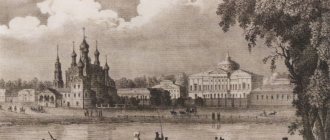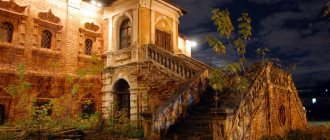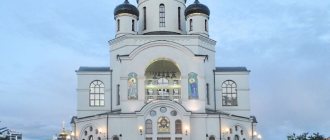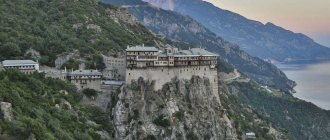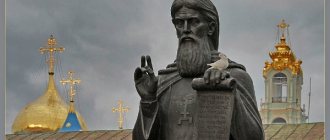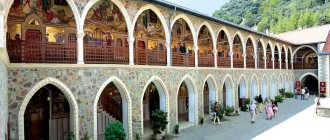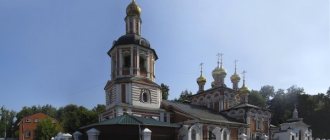Mir
Finland New Valaam Monastery Map loading in progress...
{"format":"leaflet","minzoom":false,"maxzoom":false,"limit":50,"offset":0,"link":"all","sort":[""], "order":[],"headers":"show","mainlabel":"","intro":"","outro":"","searchlabel":"\u2026 \u0441\u043b\u0435\ u0434\u0443\u044e\u0449\u0438\u0435 \u0440\u0435\u0437\u0443\u043b\u044c\u0442\u0430\u0442\u044b","default":"","import-annotation":false,"width ":"auto","height":"350px","centre":{"text":"","title":"""link":"","lat":62.56499099999999913279680185951292514801025390625,"lon": 28.785759999999999791953086969442665576934814453125,"icon":""},"title":"","label":"","icon":"","lines":[],"polygons":[],"circles":[ ],"rectangles":[],"copycoords":false,"static":false,"zoom":8,"defzoom":14,"layers":["OpenStreetMap"],"image layers":[] ,"overlays":[],"resizable":false,"fullscreen":true,"scrollwheelzoom":true,"cluster":false,"clustermaxzoom":9,"clusterzoomonclick":true,"clustermaxradius":80, "clusterspiderfy":true,"geojson":"","clicktarget":"","showtitle":true,"hidenamespace":false,"template":"","userparam":"","activeicon": "","pagelabel":false,"ajaxcoordproperty":"","ajaxquery":"","locations":[{"text":"\u003Cb\u003E\u003Ca href=\"/palomnik/%D0% 9D%D0%BE%D0%B2%D0%BE-%D0%92%D0%B0%D0%BB%D0%B0%D0%B0%D0%BC%D1%81%D0%BA%D0%B8 %D0%B9_%D0%BC%D0%BE%D0%BD%D0%B0%D1%81%D1%82%D1%8B%D1%80%D1%8C\» title=\»\u041d\u043e \u0432\u043e-\u0412\u0430\u043b\u0430\u0430\u043c\u0441\u043a\u0438\u0439 \u043c\u043e\u043d\u0430\u0441\u0442\u044b\u0440\ u044c\»\u003E\u041d\ u043e\u0432\u043e-\u0412\u0430\u043b\u0430\u0430\u043c\u0441\u043a\u0438\u0439 \u043c\u043e\u043d\u0430\u0441\u0442\u044b\u0 440\u044c\u003C/a\u003E \u003C/b\u003E\u003Chr /\u003E\u003Ca href=\"/palomnik/%D0%A1%D0%B2%D0%BE%D0%B9%D1%81%D1%82%D0%B2%D0 %BE:%D0%90%D0%BD%D0%BD%D0%BE%D1%82%D0%B0%D1%86%D0%B8%D1%8F\» title=\»\u0421\u0432\ u043e\u0439\u0441\u0442\u0432\u043e:\u0410\u043d\u043d\u043e\u0442\u0430\u0446\u0438\u044f\u003E\u0410\u043d\u043d\u043e\u 0442\u0430\u0446\u0438 \u044f\u003C/a\u003E: »'\u041d\u043e\u0432\u043e-\u0412\u0430\u043b\u0430\u0430\u043c\u0441\u043a\u0438\u0439 \u0421\u043f\ u0430\u0441\u043e -\u041f\u0440\u0435\u043e\u0431\u0440\u0430\u0436\u0435\u043d\u0441\u043a\u0438\u0439 \u043c\u0443\u0436\u0441\u043a\u043e\u 0439\u043c\u043e\u043d\ u0430\u0441\u0442\u044b\u0440\u044c»' \u0438\u043b\u0438 »'\u041d\u043e\u0432\u044b\u0439 \u0412\u0430\u043b\u0430\u0430\u03 01\u043c»' \u2014\ u0435\u0434\u0438\u043d\u0441\u0442\u0432\u0435\u043d\u043d\u044b\u0439 \u043f\u0440\u0430\u0432\u043e\u0441\u043b\u0430\u04 32\u043d\u044b\u0439 \u043c\ u0443\u0436\u0441\u043a\u043e\u0439 \u043c\u043e\u043d\u0430\u0441\u0442\u044b\u0440\u044c \u041f\u0440\u0430\u0432\u043e\u0 441\u043b\u0430\u0432\u043d\ u043e\u0439 \u0426\u0435\u0440\u043a\u0432\u0438 \u0424\u0438\u043d\u043b\u044f\u043d\u0434\u0438\u0438, \u043e\u0441\u043d\ u043e\u0432\u0430\u043d\u0432 1939 \u0433\u043e\u0434\u0443.","title":"\u041d\u043e\u0432\u043e-\u0412\u0430\u043b\u0430\u0430\u043c\u0441\u043a\u0438\u0439\u u043c\u043e \u043d\u0430\u0441\u0442\u044b\u0440\u044c","link":"","lat":62.56499099999999913279680185951292514801025390625,"lon":28.785759999999 999791953086969442665576934814453125,"icon":""}],,"imageLayers":[] }
62.684279; 28.713588
Finland, Juoyarvi
Finland
Telephone:
+358 17 570 1810
Email:
Novo-Valaam Spaso-Preobrazhensky Monastery
or
New Valaam
is the only Orthodox monastery of the Orthodox Church of Finland, founded in 1939. Located at Papinniemi Manor in Heinävesi, Finland. The Finnish name is Uusi Valamo.
History[edit]
In the former Papinniemi estate in the rural area of Häinavesi, acquired by the brethren on July 24, 1940, in Finland, the life of the monastery began, which later received the name New Valaam. The decision to purchase was made when, during an inspection of one of the rooms of the estate, a small icon of St. Sergius and Herman of Valaam was unexpectedly discovered.
After the death of Abbot Khariton, he was succeeded by Abbot Nestor, who had labored on Valaam since 1905. The Church of the Transfiguration with a refectory was built from two sheds. The manor house became the abbot's building. The abbot diligently supported Valaam traditions, including singing. The monks continued to worship their main shrine - the miraculous image of the Valaam Mother of God. In 1956, Konevskaya joined the Valaam brethren, bringing with her the miraculous Konevsky image of the Mother of God.
From 1945 to 1957, the New Valaam Monastery was under the jurisdiction of the Russian Orthodox Church, then the New Valaam Monastery was transferred to the Finnish Church. In this regard, at the request of Metropolitan Gregory (Chukov) of Novgorod and Leningrad, the leaders of the Soviet Union allowed the Valaam monks to return to their homeland. Seven monks from New Valaam became inhabitants of the Pskov-Pechersk Monastery. Here are their names: hieromonk Mikhail (Pitkevich), schema-abbot Luka (Zemskov), abbot Gennady, monk Sergius, monk Boris (in the schema Nikolai, Monakhov), hieromonk John (in the schema Laurus) and monk Gury (in the schema Herman, Sokolov). The former cell attendant of the elders, Archimandrite Kensorin, said that “these elders are the salt of the earth... They were guides, i.e. they take, as it were, their spiritual child by the hand and lead them to salvation... I come to the conviction that if monasticism collapses, then the world without monasticism will not be able to exist.”
Time passed, and by the mid-1970s. there were only two Russian monks left on New Valaam: Archimandrite Symphorian (1892-1981) and monk Akaki, who died at the age of 110 in 1984. With their death, the history of Russian New Valaam ended, which is now inhabited by Finnish monks, their community was headed by the abbot Panteleimon (now Metropolitan). Since 1977, services at the monastery have been held in Finnish and according to the new calendar style. On New Valaam, as well as in the city of Kuopio, where the only museum of the Orthodox Church in Western Europe is located, many shrines taken from Valaam back in 1940 are kept: the shrines of St. Sergius and Herman, icons, Gospels, church utensils. For the 800th anniversary of Orthodoxy in Finland, a stone Cathedral of the Transfiguration of the Savior was erected in Novgorod style on New Valaam. It was built with funds from the Society of Friends of New Valaam according to the design of the Finnish architect of Russian origin I.N. Kudryavtsev and was consecrated on June 5, 1977.
In 1984, a cultural center was erected in the monastery, combining the premises of the monastery library and archive, a conference hall, as well as a center for the restoration of icons and works of painting.
In 1989, the building of the Valaam Public School was erected next to the Transfiguration Cathedral.
In 1997, on the shore of the lake, near the monastery pier, a chapel was built and consecrated in the name of St. Nicholas the Wonderworker, and on the other side of the bay a brotherly cemetery was built, where in 1979 a chapel in the Karelian style was erected in honor of St. Herman of Alaska. In the summer of 2006, a chapel in the name of St. John the Baptist was built and consecrated next to the cemetery fence.
Abbots
- Khariton (Dunaev), abbot
(1940-1947) - Jerome (Grigoriev), abbot
(1948-1952) - Nestor (Kiselenkov), abbot
(1952-1967) - Symphorian (Matveev), archimandrite
(1969-1979) - Panteleimon (Sarkho), archimandrite
(1979-1997) - Sergius (Rayapolvi), archimandrite
(1997—2011) - Arseniy (Heikkinen), bishop
(temporary 2011-2012) - Sergius (Rayapolvi), archimandrite
(since November 22, 2012)
The warm heart of the “cold Finnish rocks”
New Valaam
The main thing is without haste
Finland encourages concentration, as many people have noticed. Even the most absent-minded cannot help but concentrate when they find themselves in the harsh Suomi in late autumn: its already not very talkative inhabitants completely withdraw into themselves, leaving not the slightest opportunity for idle conversations and an overly cheerful, superficial perception of reality. Nature favorably accepts this humility, and light rain from low-hanging clouds, gusts of the north wind rocking the pine ocean, can sometimes even be replaced by glimpses of the sun’s rays, making one smile sadly: “Oh, forest! Teach me to die without sadness!” Finns, experienced in such matters, despite all the external severity - both their own and nature's - are still in no hurry to die: “A cup of good Finnish coffee in this weather won’t hurt. But two cups of good Finnish coffee is better. In addition, the second and each subsequent one is free. Will you have some coffee? – “Who would refuse good old Finnish coffee? Oh, those endless sunny Finnish coffee plantations!” - “Would you like to joke?” - “Yeah.” - “Then come in! How's the road? Are you very tired?
Venerable Sergius and Herman of Valaam
The journey from Helsinki to New Valaam takes approximately six hours by bus. Honestly, after the time spent on the road, I want to joke: the autumn seriousness of the surrounding reality sometimes requires a smile. In addition, our eternal neighborly jokes and jokes in relation to each other, if, of course, they are kind and respectful, cannot but cause it. And kindness and respect are greatly promoted by the desire to find out what we have in common - that’s what I came here for. What can bind peoples together stronger and better than a common faith? – The New Valaam Monastery has a lot to tell. For example, it is somewhat hasty to diagnose total apostasy of “bad Europe”. Here in Suomi, as you know, they don’t like rushing. And quietly, persistently they continue to live with Christ, keeping this very Europe afloat, despite the really serious, terrible challenges that are heard, however, not only here, it must be admitted. Sometimes, with his quietness, perseverance and loyalty to God, he sets a worthy example for some hot guys from abroad to follow.
Why is Finnish Valaam New? Everything is simple and, alas, sad: Old Valaam was ruined and devastated during the years of godless hard times in Russia. Before the Winter War, the holy monastery on Lake Ladoga was part of Finland, but in the winter and spring of 1940 it found itself within the borders of then Soviet Russia. Based on the example of Solovki and other monasteries of the devastated Holy Rus', one can guess what fate the new owners were preparing for Old Valaam. To avoid this fate, the monks, as well as the workers of the Valaam Monastery - Russians, Finns, Korels - left the ancient monastery and settled near the city of Heinävesi, where a new monastery later arose. On the ice of Lake Ladoga, accompanied by army units, the monks of Old Valaam walked and rode, taking with them the pain for tormented Russia, and ancient shrines, and the huge library for which the monastery was famous.
Tragedy? Yes, and scary! But, according to the rector of New Valaam, Archimandrite Sergius (Rayapolvi), often it is tragedies that God can use for salvation. We talk with him about Orthodoxy in the country of Suomi, about the life of the Spaso-Preobrazhensky New Valaam Monastery.
Archimandrite Sergius (Rayapolvi)
– Father Sergius, how did this monastery appear in Finland?
– For four months - from December 1939 to March 1940, during a war terrible for both our countries, the evacuation of monastics from the Valaam Monastery took place deep into Finland, which was not in danger of falling under the rule of the Bolsheviks. Most of the refugees left Valaam in February, across the ice of Lake Ladoga. The winter was terribly cold then, and the ice on Ladoga, thank God, was able to withstand the refugees: they left the monastery on trucks of the Finnish army, which helped the last inhabitants of the old monastery. The Finnish army helped in the evacuation of the monastery: monastics, a huge archive, many icons, and other valuables that were threatened with complete destruction, as we know from the example of the monasteries of devastated Russia. For example, in Orthodox Karelia alone, which after the war found itself under the rule of atheists, more than 90% of the churches were destroyed, among which were pearls of stone and wooden architecture.
By decision of the government, dozens of churches were built in Finland: after all, the majority of refugees from Karelia were Orthodox. Thus, temples appeared in other parts of Finland. Previously, there were churches in big cities - in Helsinki, Vasa, Tampere, Turku, and they were built in imperial times, but there were practically no Orthodox churches in the provinces.
– This explains why most churches in Finland are hardly older than 60 years?
Orthodox refugees appeared in Finland in 1940, and new churches began to be built throughout the country. It was a spiritual sowing
– Absolutely right: they began to be built after Orthodox refugees appeared. In general, speaking about the tragedy of the revolution - in Russia and Finland, about fratricidal wars, it is necessary, in my opinion, to be able to see the action of God's Providence. It would seem that terrible, terrible things are happening - the death of people, the destruction of holy monasteries and temples, and the like. But the Lord, even in such conditions, continues the work of salvation: after all, due to the fact that Orthodox refugees appeared, they spread throughout Finland. New churches began to appear throughout the country, and the Liturgy began to be celebrated. It was a spiritual sowing, the sowing of gospel seeds.
– Just like in Russia during the time of St. Sergius of Radonezh: there were very difficult times - occupation, fragmentation, civil strife, but, nevertheless, rays of Christianity emanated from the monastery of the Monk, his disciples founded monasteries throughout Russia?
- Yes it is. As we see, there are no external barriers to the Word of Christ - even terrible times can, according to the Providence of the Lord, serve the salvation of many.
– Who now makes up the Finnish Orthodox Church? Who are these people?
– The Orthodox Church of Finland is the second Christian denomination in the country. Officially, there are 61,500 Orthodox Christians here, which is approximately 1% of the country's total population. The majority of the Christian population is Lutheran: about 70%.
Of the main challenges for the Church today, I would probably note the movement to leave the Christian Churches. In other words, secularization. It is very strong: more and more people are trying to leave the Church, especially the Lutheran Church. But she has her own difficulties. For example, talk about the official recognition of so-called homosexual “marriages” by the Lutheran Church is becoming louder, but the outflow of parishioners continues. The Orthodox Church, of course, never recognizes such “marriages.”
– What is the reason, in your opinion, for this secularization?
- In abundance. No, not even in abundance, but in its excess. “Why is God needed if a person is well-fed, rich and healthy”?
Today, leaving church is easy - you can do it with a couple of clicks on the tax service website
Most Finnish Orthodox Christians now live in the Helsinki region or in the southwest of the country - these regions attract residents of the less developed and “promising” north, east and central parts of Finland. Atheistic propaganda is especially developed in the capital; the movement called “Leave the Church” is very active and aggressive. Using all kinds of advertising campaigns and PR campaigns, it calls on people to leave the Christian Church and stop paying church tax. Indeed, in Finland, as in Germany and other countries, there is a church tax, which is paid by taxpayers - members of the Church, it amounts to 1-2% of income, and the Church largely exists and operates with this money. Atheistic propaganda calls for refusing to pay this tax and finding other uses for the money - many do this. It’s not difficult: they go to the website of the tax service and, in a couple of “clicks,” declare themselves as people who left such and such a denomination and, therefore, do not want to pay money for its maintenance.
New Valaam
– It turns out interesting: two widow’s mites turn into two “clicks” worth 30 pieces of silver.
- It may very well be. But in fairness, I must say: among those who left the Church just like that, “in two clicks,” there are also those who later return to it.
– Father Sergius, you spoke about prosperity as the main reason for a person’s refusal of God. Sorry, but I don’t agree with you on everything here. Let us again take the sad Soviet times for both of our countries: in Russia the Church was persecuted, churches were burned and destroyed, God was blasphemed by people who lived in conditions, to put it mildly, that were far from the most comfortable. The poor people destroyed the churches. Poor people ridiculed the Church in later times. Why is this, you don’t know?
– When people are very poor, they may be painfully aware of the wealth gained through the use of their labor. And the Church in Russia, I mean the earthly Church, before the revolution, to call it financially poor, in my opinion, was very difficult. Huge possessions, earthly riches of the earthly Church... You know, I thought for a long time why the Russian people destroyed churches with such force. I am not completely sure of the correctness of my conclusions, but I believe that the earthly Church has forgotten about its calling. I mean helping the poor, diakonia, service.
– For what reasons do people come to the New Valaam Monastery?
“Poor people constantly come to our monastery for help. For completely different reasons, people come here: someone really does not have enough food or clothing, a huge number are looking for spiritual consolation - everyone who comes has their own troubles, and it is the duty of a Christian to help. We are trying to do this.
- So who are these people? Homeless people, emigrants who have lost the meaning and purpose of life, alcoholics, drug addicts - who are they?
- There are many of them. Both Finns and Russians, from very different walks of life. They contact us for a variety of reasons. Economic difficulties are surmountable: we have a good social assistance system, and the monastery helps to establish connections with social services, with the employment service, and sometimes helps to find a job itself.
– But they also ask for spiritual help, perhaps?
Not only Orthodox Christians come to the monastery, but also Lutherans and non-believers. Sometimes, after spending several days here, they decide to convert to Orthodoxy
- Yes, every day! Confession in the monastery, one might say, does not stop. When I say “confession,” I also mean spiritual conversations: after all, not only Orthodox people come to New Valaam, but also Lutherans and non-believers. Sometimes, after spending several days, or even hours, in a monastery, people decide to convert to Orthodoxy. They become students of catechism courses at our lay academy and then convert to Orthodoxy. Moreover, there are courses in the fundamentals of Orthodoxy at every large parish in Finland, and hundreds of people take it throughout the country. A few days ago, a former female pastor converted from Lutheranism, and, by the way, there have been many such cases in recent years.
– Are there any famous shrines in the New Valaam Monastery?
– These include, for example, the miraculous icons of the Mother of God – Valaam and Konevskaya. There are many other shrines.
– What is the situation with the teaching of Orthodoxy in Finnish schools?
– Our education system implies: if there are three students in a school who profess Orthodoxy, then the state is obliged to provide them with the opportunity to study it, that is, it pays for the work of the teacher. If less than three, then the Church pays for tuition. And the Church does this: if, let’s say, there are two Orthodox students in one school, one in another, and so on, then we pay for transport for the students - they go to Orthodoxy lessons in larger schools.
– Isn’t it unprofitable?
– No, not “unprofitable”: the Church is ready to spend money on education. The Church spares no money on education.
From the 1st grade of school to the last - be it a school or a gymnasium - Orthodoxy is taught. We have developed textbooks for all classes, of course, at different levels of difficulty. A few years ago we developed new teaching aids.
– Do you wish anything for our readers?
– Be faithful to Orthodoxy, always live in the Church - experience your faith with your heart, mind and deeds!
Monks, Nixu and Saint Ignatius
Today there are 12 monks in the New Valaam Monastery. It would seem not so much compared to large monasteries. But the prayer and work of these 12 people brings thousands of people here. There is also a Cultural Center here, which unites icon-painting and restoration workshops, a huge library and a simply stunning archive, saved by monks from destruction in 1940. Some kind of educational events are constantly held in the monastery. Quite recently, for example, the seminar “Getting to know Orthodoxy. Sacred Scripture and the Tradition of the Church." Classes are most often conducted in two languages: Finnish and Russian. What is encouraging is that there is always great attention to educational courses, so Archimandrite Sergius’s hope for spreading the light of Orthodoxy in Finland seems to be quite justified.
And the archive is truly impressive! The chief archivist, Abbot Cassian, showed me with delight, for example, the usual report of a visit by some Archimandrite Ignatius to the Valaam Monastery in 1838. Well, it would seem, he visited and visited. Well, I left a couple of notes in beautiful handwriting.
- Look at the signature!
– Archimandrite Ignatius.
- Read on.
- Brianchaninov. Brianchaninov?!
- He is. Saint Ignatius was appointed at this time dean of the monasteries of the St. Petersburg diocese. He contributed to the flourishing of the spiritual life of monasticism, including the Valaam Monastery. Here, in the archive, there are many letters from the saint to the brethren, which talk about different aspects of spiritual leadership. By the way, here is a small excerpt from his notes: “Monastic life on Valaam and the eastern confession of the Christian faith in that country flourished much earlier and stronger than what a traveler could conclude with a superficial visit to the region, with a short glance at it... Residents of the shores professed the Orthodox faith , borrowing its knowledge from the Valaam monastery; Orthodox churches stood along the shore all the way to Kexholm. The Korelians of this shore of Lake Ladoga were Orthodox, just as the Korelians of the opposite shore, the inhabitants of the Olonets province, are Orthodox now...
Saint Ignatius: “Hardly many people know that Orthodoxy is alive in the depths of Finland, that it is not newly planted, but has lived there since ancient times...”
But the unfortunate time came - the Finns leaned towards the teachings of Luther. In the places where Orthodox churches stood, where Orthodox services were performed, where the Divine Liturgy united heaven with earth, Lutheran kirks now stand, resounding only with the meager sermon of a cold pastor... Hardly many people know that in the depths of Finland Orthodoxy is still alive, that it is not newly planted, lives there from time immemorial, a remnant of the common ancient Christian religion that replaced paganism... The religious fate of the Finnish coast, in union with the fate of the Valaam monastery, from which, apparently, religious life for the whole country has always flowed, as from the heart, has flourished and diminished , depending on how much or little strength the Valaam Monastery gave her.
At the beginning of the 17th century, the Swedish commander Pontus de la Gardie, who caused so much harm to Russia, destroyed the Valaam monastery; he betrayed churches and cells to flames, monks to the edge of the sword; some fled, taking with them the relics of the holy founders of the monastery. The left bank of Finland suffered a similar fate: Orthodox churches were burned; clergy killed or expelled; Lutheranism was widespread among the inhabitants, whose followers still breathed a fanatical passion for their newly born faith, which was preparing to wash itself in the blood of the Thirty Years' War. It is worthy of note that the villages that have preserved the Orthodox faith are not located on the very shore of Lake Ladoga, not on the path of the conquerors, but deeper in Finland, behind the mountains, behind the swamps - the natural fences of the country: they hid there, they were saved from the gaze and religion of the Protestants. At this time, many Finns fled to Russia to preserve the faith...” - St. Ignatius talks about how Orthodoxy in the country of Suomi has deep roots, that it is natural for its inhabitants.
“Visitors to the monastery are accommodated in a hotel. There is also a special shelter for the beggars that this part of Finland is rich in. The poor are allowed to stay on Valaam for two days and enjoy a meal specially prepared in their shelter, and each person is given two pieces of rye bread for the journey. And for this alms the Finnish man strives 40, 50 versts to the Valaam Monastery! – after a century and a half, these words are read somewhat differently: with respect for the “Finnish people” who managed to turn their home into a worthy country.
The archive is impressive: letters from St. Herman of Alaska, Equal-to-the-Apostles Nicholas of Japan, notes from St. Ignatius (Brianchaninov)…
Father Cassian can give a whole lecture about every seemingly insignificant at first glance document, dry report, or anything else. On history, geography, architecture, cartography, and even geopolitics - I’m not even talking about theology. He unfolds old documents - you see, for example, letters from missionaries sent from Valaam to Alaska in 1794. One letter contains the autograph of St. Herman of Alaska and the Hieromartyr Juvenal - this letter talks about the safe arrival of missionaries from Irkutsk to Okhotsk and preparations for the voyage to Alaska. There is also a letter from Equal-to-the-Apostles Nicholas of Japan, in which the saint asks to send him one of the brethren to help in missionary work and describes the qualities that a missionary should have.
There are a lot of books - my eyes run wild. From the “Alphabetical Index to All Cases,” covering the period from 1836 to 1918, for example, you will learn that data from the monks’ meteorological observations were received by the Academy of Sciences; that the Knights of St. George were in the Valaam Monastery in 1869; that in 1880 the Finnish Orthodox Brotherhood was founded; that the monastery acquired “hydropolettes” (fire extinguishers)... There are also stories about the coup d’etat of 1917, about the transition from Old Valaam to New Valaam and with the associated obstacles. In general, Father Cassian enrolled me in the library of the New Valaam Monastery and strictly invited me to come more often and sit in the monastery library and archive longer.
New Valaam
And in this monastery there is a black cat - Nixu. He lives for himself and doesn’t give a damn: people love him here. Moreover: they turned his cat-like persona into a humorous and kind symbol of the monastery by printing postcards with his image. I don’t know if the Finnish language has a proverb about a cat and Maslenitsa – judging by Nix’s happy face, no. Although, who knows, who knows...
There are several pilgrimage routes from the monastery - to the worship cross on the shore of the lake, to the Lintula Orthodox women's monastery, and a small roundabout route through the old cemetery. It seems to me that it makes sense to take advantage of these quiet, calm paths - your soul becomes lighter. Come.
Current state[edit]
The monastery complex includes:
- Transfiguration Cathedral
The main temple of New Valaam is located in the very heart of the monastery. The temple was built in 1977. In the same year, the language of worship was changed from Russian to Finnish, and the Julian calendar to Gregorian. Every day, 14 bells brought from Ladoga Valaam call believers to prayer from the bell tower of the Main Temple.
- Winter Church (or Church of Sergei and Herman of Valaam)
It is a chapel of the Transfiguration Church.
- Old Church (or Church of All Saints Who Shined On Valaam)
The oldest of the monastery churches. Almost all church utensils and icons in the church were brought from Ladoga Valaam. Until 1977, all services were held in the Old Church; currently, services are held there only in the summer.
- Chapel in the name of St. Nicholas the Wonderworker
Located on the shore of Lake Juoyarvi, next to the monastery pier. The chapel is locked, if you want to pray, just take the key from the reception. This allows for privacy; no one will disturb you during prayer.
- Chapel in the name of St. Herman of Alaska
The chapel was built in 1981 and is located in the monastery cemetery, about a kilometer from the main church. You can walk or drive to the cemetery; there is parking near the entrance.
- Chapel in the name of St. John the Baptist
Another chapel located in the monastery cemetery. This is the newest of our chapels, built in 2006.
You can learn more about the history of the monastery, its miraculous icons, church utensils and monastery buildings by visiting the exhibition in the Cultural Center of the monastery or by taking part in a tour of the monastery.
View map of the monastery
From the history of the Valaam Transfiguration Monastery in Finland
... On November 26, 1939, finding itself in the thick of the Soviet-Finnish war, Valaam was bombed by Soviet aircraft for the first time. A few days later, on December 9, the barbaric air raid on the monastery was repeated again.
And in the second half of December, in the context of ongoing hostilities, the intensity of which seemed to only increase, the forced evacuation of the monastic brethren began. And, as it turned out a little later, on time - in January-February 1940, the bombing of the monastery by Soviet aircraft repeated again and became even more frequent.
Fortunately, during the hasty evacuation in December 1939, none of the monastery authorities and brethren were injured. The monks managed to take with them all the most valuable things that remained in the monastery at that time.
The monks who left Valaam moved to the formerly private estate of Papinniemi in the future Eastern Finland, where little by little, day after day, they began to slowly equip their new home - New Valaam.
Patronal holidays[edit]
- Transfiguration of the Lord
- August 19 - Herman and Sergius of Valaam, reverends
- July 11, September 24 - Council of Valaam Saints
- August 22 (movable) 1st Sunday after August 6/19 - Nicholas the Wonderworker, Archbishop of Myra, Saint
- May 22, December 19 - Herman of Alaska, Rev.
– August 9 - Herman of Alaska, Rev.
– August 9
How to get there[edit]
Address:
Valamontie 42, 79850 Uusi-Valamo, Finland
Directions:
by car or regular bus:
- By car:
Address for navigator: Valamontie 42, 79850 Uusi-Valamo - Navigator coordinates: 62°33'40.6″N 28°47'36.0″E
- Coordinates on Google map: 62.561284, 28.793321
- Suitable routes can be found on the official website of the monastery
- By transport from St. Petersburg: Bus St. Petersburg - New Valaam
(3 times a week). - Train St. Petersburg-Lakhi + bus Lahti-New Valaam
. By train St. Petersburg-Lahti (Allegro) and then by bus No. 38 Lahti-monastery (departs from Lahti daily at 14:30, arrives at the monastery at 18:30.
- By transport from Moscow: Moscow - Lahti - New Valaam
. By train Moscow-Lahti (Lev Tolstoy) and then by bus No. 38 Lahti-monastery (departs from Lahti daily at 14:30, arrives at the monastery at 18:30. - Moscow - St. Petersburg - New Valaam
. By train Moscow-St. Petersburg (any) and then by bus St. Petersburg-monastery (St. Petersburg-Valaam Wed, Fri and Sun, Valaam-St. Petersburg Mon, Thu and Sat).
More details on the monastery website
Telephone:
+358 17 570 1810
Email:
How to get there on your own
You can also get to Valaam on your own. Usually they get there through the city of Sortavala, from where there are regular flights during the navigation period. Check the cost yourself, it changes every year. Also keep in mind that navigation usually starts in May and ends at the end of October. There is also an option through Priozersk, perhaps there is departure of small vessels from other settlements of the Republic of Karelia, which are located on the shores of Lake Ladoga (Lakhdenpokhya, etc.), but you should look for this opportunity on your own (for example, on social networks).
It is very important to know the weather forecast; if there is a strong storm on Ladoga, then it is far from certain that you will be able to get to the archipelago. In this sense, buying a cruise on a ship is better than traveling on your own - it’s more reliable. This problem is especially relevant for guests from distant regions. Residents of the Leningrad region can get to Sortavala in a few hours, and in case of bad weather it is easy to cancel the trip.
There are hotels on Valaam; the cost of accommodation can be found on the official website of the monastery.
Author Alexxx1979 (own work)
How to get to Valaam when there is no navigation?
If you want to get to Valaam in winter, early spring or late autumn (this is November, December, January, February, March, April), then you may encounter certain difficulties. If in the middle of winter you can get from Sortavala to the archipelago by car (if the ice allows it) or by snowmobile or ski (there are also such active recreation options), then during the period when there is no navigation, but there is also no ice, there is only one option - helicopter.
Helicopters to Valaam fly from St. Petersburg, but the cost is of course high. The minimum prices that can be found are 50 thousand rubles per person. In addition, flying to the Valaam archipelago in November, for example, is not the most reasonable decision. At this time of year, there is often no snow yet, and the landscapes are very dull. That is, there is no need to pay a lot of money for a helicopter (in our opinion). It's easier to go during the navigation season.
With tents on Valaam
The option of relaxing with tents on Valaam is not without appeal; nevertheless, the nature here is very beautiful, and in order to feel the local atmosphere, several hours (a standard visit) are clearly not enough. You can stay in a hotel, but if you are a fan of camping, then you have this opportunity, even though the Valaam archipelago is a nature reserve.
There are specially organized places where it is allowed to pitch tents and light fires. To organize a parking lot, you need to obtain permission from the monastery administration (you will be given a coupon for setting up a tent). It is prohibited to pitch tents in other places. By the way, you can also rent a bicycle at the monastery administration. The cost of a permit to set up a tent on Valaam is small, around 100 rubles per day per person.
The best time to relax on Valaam with tents is summer. May can still be too cold, and September can be very rainy. Well, October is a month for extreme sports, at this time it is not only cold and rainy, but at times very windy.
All ships arrive at Monastyrskaya Bay, where the pier is located.
Pilgrim[edit]
Hotels[edit]
The monastery offers guests a choice of economical rooms with amenities on the floor (guest house) or rooms with all amenities (3 hotels). The price of any room always includes breakfast in the Trapeza restaurant:
- Guest house
(1-3 bed rooms with amenities on the floor. 2-storey building, on each floor 2 showers, 2 toilets and 18 rooms). - Main hotel
(1-2 bed rooms with all amenities, in some rooms it is possible to add 1-2 extra beds. Each room has a shower, toilet, tea and coffee making facilities). - Small hotel
(only single rooms, it is possible to add one extra bed (chair-bed). Shared shower and toilet for 2-4 rooms). - Hotel at the school
(1-2 bed rooms with all amenities, no extra beds. Each room has a shower and toilet).
Room reservations are made on the official website of the monastery
Refectory[edit]
- Cafe-restaurant Trapeza
More details on the website
general description
Valaam is one of the most famous monasteries in Russia. Located on the island of the same name, which is part of the Valaam archipelago. Administratively it belongs to the Sortavala region of the Republic of Karelia. You can read more about the archipelago and the island itself in a separate article.
Valaam is a very popular tourist destination; in Karelia it is one of the most visited places (we are talking only about tourists, not pilgrims). It is located in the northern part of Lake Ladoga, in the area of skerries, which is why these places are so popular. It is truly very beautiful here, the local landscapes can leave few people indifferent, and the very beautiful architecture complements the overall impression.
If you are going to visit Karelia, especially if you are going to the Northern Ladoga region, be sure to plan a visit to Valaam. It will take you one day, but the memories of this very interesting and beautiful place will last a lifetime.
Photo[edit]
- Transfiguration Cathedral
- New Valaam Monastery
- Prpp. Herman and Sergius of Valaam
- Interior of the Transfiguration Cathedral
- Interior of the Transfiguration Cathedral
- Interior of the Transfiguration Cathedral
- Interior of the Transfiguration Cathedral. Winter Church
- Interior of the Transfiguration Cathedral
- Chapel in the name of St. Nicholas the Wonderworker
- Chapel in the name of St. Herman of Alaska
- Chapel in the name of St. John the Baptist
- Old Church building
Links[edit]
- Official website of the Valaam Transfiguration Monastery in Finland
- Official page of the Valaam Transfiguration Monastery in Finland VKontakte
- Official website of the Valaam Monastery. New Valaam
- Collaboration in the New Valaam Monastery
- Finnish Spaso-Preobrazhensky New Valaam Monastery
- New Valaam
- Uusi-Valamo Monastery. New Valaam Monastery
- New Valaam Monastery
- Remembering. New Valaam
- New Valaam - Orthodox monastery in Finland
- Valaam in Finland
- New Valaam
- New Valaam
New Valaam today
Today, New Valaam - the New Valaam Monastery of the Transfiguration of the Savior is the only male monastic monastery of the Finnish Orthodox Church and one of the two most prominent tourist attractions in Heinävese, in Southern Savonia, near the modern Finnish-Russian state border.
By the way, the second tourist attraction of this area from among the Orthodox shrines is the only and still small female monastic monastery of the same Finnish Orthodox Church located right there, nearby - just 18 km away - the Lintulsky Monastery, which at one time repeated the fate of the Valaam Monastery - its, Lintulsky monastery of the Russian Orthodox Church, the nuns of the pre-war period were also forced to leave their former place of residence on the Karelian Isthmus as a result of hostilities during the Soviet-Finnish war.
The Novo-Valaam Spaso-Preobrazhensky Monastery is an indispensable participant in the pilgrimage program of the Russian pilgrimage brotherhood of the Russian Orthodox Church “Radonezh”. The result of the closest cooperation between the monastery and the Radonezh brotherhood was an increase in the number of tourists and pilgrims from Russia, the annual flow of which currently amounts, according to various estimates, from 15 to 25 thousand people.
And in 2012, the name New Valaam thundered throughout Finland - then this monastery was recognized as the best tourist attraction in Suomi.
The latter is not at all surprising - tourism and pilgrimage currently constitute almost the main source of the monastery’s income, which is quite modest in modern times, and to receive so many guests, a guest house has been built on its territory, for which one of the old buildings of the New Valaam monastery has been adapted.
In addition, the monastery has an information and cultural center, a public school with a hotel, and a church (read: souvenir) shop. There is also a restaurant here with the self-explanatory name “Trapeza”. By the way, the conference hall of the local cultural center is designed for no less than 300 seats; there is also a monastery library and exhibition halls, one of which houses a permanent exhibition dedicated to the history of New Valaam.
Another source of income for the Spaso-Preobrazhensky Monastery is the production of table wine and malt whiskey. True, not everything is so simple here - in Suomi there is a state monopoly on alcohol, and therefore the monastery is obliged to officially order these products from the Finnish alcohol monopolist, the company Oy Alkoholiliike Ab, whose activities are officially confirmed and regulated by the relevant legislative acts not only of Finland, but also of the European Union . Moreover, the latter directly prohibit the sale in Finland of alcohol originating from other EU countries.
It is interesting that the monastery does not have the fortress walls familiar to Russian people, and it itself is located in an open area.


